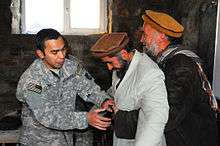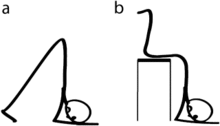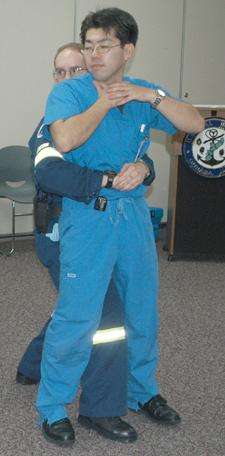Choking
| Choking | |
|---|---|
|
A demonstration of abdominal thrusts on a person showing signs of choking | |
| Classification and external resources | |
| Specialty | Emergency medicine |
| ICD-10 | F41.0, R06.8, T17, W78-W80 |
| ICD-9-CM | 784.9, 933.1 |
| MeSH | D000402 |
Choking is the mechanical obstruction of the flow of air from the environment into the lungs. Choking prevents breathing, and can be partial or complete, with partial choking allowing some, although inadequate, flow of air into the lungs. Prolonged or complete choking results in asphyxia which leads to anoxia and is potentially fatal. Oxygen stored in the blood and lungs can keep a person alive for several minutes after breathing stops.[1]
Choking can be caused by:
- Physical obstruction of the airway by a foreign body.
- Respiratory diseases that involve obstruction of the airway.
- Compression of the laryngopharynx, larynx or vertebrate trachea in strangulation.
- Laryngospasm, a temporary closing of the vocal cords, which simulates the feeling of choking.
Obstruction of the airway can occur at the level of the pharynx or the trachea. Foods that can adapt their shape to that of the pharynx (such as bananas, marshmallows, or gelatinous candies) can be a danger not just for children but for persons of any age.[2]
Choking due to a foreign object resulted in 162,000 deaths in 2013 up from 140,000 deaths in 1990.[3]
Symptoms and signs
- The person cannot speak or cry out, or has great difficulty and limited ability to do so.
- Breathing, if possible, is labored, producing gasping or wheezing.
- The person has a violent and largely involuntary cough, gurgle, or vomiting noise, though more serious choking victims will have a limited (if any) ability to produce these symptoms since they require at least some air movement.
- The person desperately clutches his or her throat or mouth, or attempts to induce vomiting by putting their fingers down their throat.
- If breathing is not restored, the person's face turns blue (cyanosis) from lack of oxygen.
- The person does any or all of the above, and if breathing is not restored, then becomes unconscious
Cause
The type of choking most commonly recognized as such by the public is the lodging of foreign objects (also known as foreign bodies, but consisting of any object which comes from outside the body itself, including food, toys or household objects) in the airway.[4]
This type of choking is often suffered by small children, who are unable to appreciate the hazard inherent in putting small objects in their mouth.[5] In adults, it mostly occurs while the patient is eating. In one study, peanuts were the most common obstruction.[6]
Treatment

Choking can be treated with a number of different procedures, with both basic techniques available for first aiders and more advanced techniques available for health professionals.
Basic treatment includes a number of procedures aiming at removing foreign bodies from the airways. Most modern protocols, including those of the American Heart Association and the American Red Cross, recommend several stages, designed to apply increasingly more pressure. Most protocols recommend encouraging the victim to cough, followed by hard back slaps and if none of these things work; abdominal thrusts (Heimlich maneuver) or chest thrusts.
The American Medical Association advocates sweeping the fingers across the back of the throat to attempt to dislodge airway obstructions, once the choking victim becomes unconscious.[7] However, many modern protocols recommend against the use of the finger sweep since, if the patient is conscious, they will be able to remove the foreign object themselves, or if they are unconscious, the rescuer should simply place them in the recovery position as this allows (to a certain extent) the drainage of fluids out of the mouth instead of down the trachea due to gravity. There is also a risk of causing further damage (for instance inducing vomiting) by using a finger sweep technique.
The advanced medical procedure to remove such foreign objects is inspection of the airway with a laryngoscope or bronchoscope, and removal of the object under direct vision. Severe cases where there is an inability to remove the object may require cricothyrotomy (emergency tracheostomy). Cricothyrotomy involves making an incision in a patient's neck and inserting a tube into the trachea in order to bypass the upper airways.[8] The procedure is usually only performed when other methods have failed. In many cases, an emergency tracheostomy can save a patient's life, but if performed incorrectly, it may end the patient’s life.

Multiple evidence suggest, that one of promising approaches for self treatment during choking could be by applying the head-down (inversed) position[9]
Notable cases
- Hollywood star Clint Eastwood saved a man from choking on 5 February 2014 in California.[10]
- The former President of the United States, George W. Bush, survived choking on a pretzel on January 13, 2002, an event that received major media coverage.[11]
- Jimmie Foxx, a famous Major League Baseball player, died by choking on a bone.[12]
- Tennessee Williams, the playwright, reportedly died after choking on a bottle cap. This was later disputed.[13]
- An urban legend states that obese singer Mama Cass choked to death on a ham sandwich. This theory arose out of a quickly discarded speculation by the coroner, who noted a partly eaten ham sandwich and figured she may have choked to death. In fact, she died of a heart condition, often wrongly referred to in the media as heart failure.[14]
- Queen Elizabeth The Queen Mother notably experienced three major choking incidents where a fish bone became lodged in her throat: initially on 21 November 1982, when she was taken from Royal Lodge to the King Edward VII Hospital for an operation at 3am;[15] secondly in August 1986 at Balmoral, when she was taken to the Aberdeen Royal Infirmary, though no operation was needed;[15] and in May 1993, when she was admitted to the Aberdeen Infirmary once again for an operation under general anaesthetic.[16]
- Air Marshal Subroto Mukerjee, the first Chief of the Air Staff of the Indian Air Force (IAF), died on 8 November 1960 at Tokyo by choking on a piece of food lodged in his windpipe.[17]
- Dr Henry Heimlich himself saved a fellow retirement home resident from choking in late May 2016.[18]
See also
References
- ↑ Ross, Darrell Lee; Chan, Theodore C (2006). Sudden Deaths in Custody. ISBN 978-1-59745-015-7.
- ↑ Sayadi, Roya (May 2010). Swallow Safely: How Swallowing Problems Threaten the Elderly and Others (First ed.). Natick, MA: Inside/Outside Press. pp. 46–47. ISBN 9780981960128.
- ↑ GBD 2013 Mortality and Causes of Death, Collaborators (17 December 2014). "Global, regional, and national age-sex specific all-cause and cause-specific mortality for 240 causes of death, 1990-2013: a systematic analysis for the Global Burden of Disease Study 2013.". Lancet. 385: 117–71. doi:10.1016/S0140-6736(14)61682-2. PMC 4340604
 . PMID 25530442.
. PMID 25530442. - ↑ "Foreign Body Aspiration: Overview - eMedicine". Retrieved 2008-12-16.
- ↑ "Choking Prevention". American Academy of Pediatrics (healthychildren.org). 2010-06-14.
- ↑ Yadav SP, Singh J, Aggarwal N, Goel A (September 2007). "Airway foreign bodies in children: experience of 132 cases" (PDF). Singapore Med J. 48 (9): 850–3. PMID 17728968.
- ↑ American Medical Association (2009-05-05). American Medical Association Handbook of First Aid and Emergency Care. Random House. ISBN 978-1-4000-0712-7.
- ↑ "What is a trahceostomy?". Retrieved 25 February 2014.
- ↑ Luczak (2016.02.015). "Head-down self-treatment of choking". Resuscitation. doi:10.1016/j.resuscitation.2016-02-15. Check date values in:
|date=(help) - ↑ "Hollywood star Clint Eastwood saves man from choking". BBC News. 2014-02-08.
- ↑ "Bush makes light of pretzel scare". BBC News. 2002-01-14. Retrieved 2007-06-15.
- ↑ "Jimmie Foxx Obituary". Retrieved 2007-06-15.
- ↑ "Biography of Tennessee Williams". IMDB. Retrieved 2007-06-15.
- ↑ "Urban Legend of Mama Cass choking". Snopes Urban Legend Reference. Retrieved 2007-06-15.
- 1 2 Vickers, Hugo (2005). Elizabeth, the Queen Mother. London: Hutchinson. p. 449. ISBN 0-09-180010-2.
- ↑ "Queen Mother recovers after operation". BBC News. 1999-01-25. Retrieved 2009-08-22.
- ↑ "The Saga of a Soaring Legend". http://www.indianairforce.nic.in. IAF. Retrieved 20 January 2015. External link in
|website=(help) - ↑ Walters, Joanna (2016-05-27). "Dr Henry Heimlich uses Heimlich manoeuvre for first time at 96". the Guardian. Retrieved 2016-06-07.
